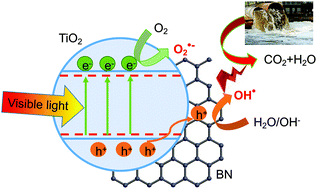当前位置:
X-MOL 学术
›
Photochem. Photobiol. Sci.
›
论文详情
Our official English website, www.x-mol.net, welcomes your
feedback! (Note: you will need to create a separate account there.)
Enhanced visible light photocatalysis by TiO2-BN enabled electrospinning of nanofibers for pharmaceutical degradation and wastewater treatment.
Photochemical & Photobiological Sciences ( IF 2.7 ) Pub Date : 2019-11-06 , DOI: 10.1039/c9pp00304e Lu Lin 1 , Wenbin Jiang 1 , Maryline Nasr 2 , Mikhael Bechelany 2 , Philippe Miele 2 , Huiyao Wang 1 , Pei Xu 1
Photochemical & Photobiological Sciences ( IF 2.7 ) Pub Date : 2019-11-06 , DOI: 10.1039/c9pp00304e Lu Lin 1 , Wenbin Jiang 1 , Maryline Nasr 2 , Mikhael Bechelany 2 , Philippe Miele 2 , Huiyao Wang 1 , Pei Xu 1
Affiliation

|
Boron nitride (BN) nanosheets are promising support materials for catalysts. A series of TiO2-BN enabled electrospun nanofibers were synthesized for the photocatalytic treatment of ibuprofen and secondary wastewater effluent under visible light. X-ray photoelectron spectroscopy confirmed the existence of B-O-Ti bonds between the BN nanosheets and TiO2 nanofibers, resulting in energy rearrangement, narrowed band gaps, and enhanced light utilization efficiency of the TiO2-BN nanocomposites in the visible light spectrum. Transient photocurrent measurements revealed that the BN enhanced the transport of photogenerated holes from the bulk TiO2 nanofibers to its surface, resulting in more efficient separation and less recombination of the charge carriers. A kinetic study of ibuprofen degradation indicated the enhanced photocatalytic performance of TiO2-BN catalysts with a higher BN content in the nanocomposites. The kinetic rate constant of the TiO2-10% BN catalysts was 10 times higher than that of the pure TiO2 nanofibers. The degradation of organic contaminants in wastewater followed the same trend as ibuprofen and improved with increasing BN content. The stability of the TiO2-BN nanocomposites as an effective solar photocatalyst was demonstrated by multiple cycles of wastewater treatment. The results proved that TiO2-BN is an appealing photocatalyst under visible light.
中文翻译:

TiO2-BN增强了可见光的光催化能力,使纳米纤维能够静电纺丝,用于药物降解和废水处理。
氮化硼(BN)纳米片是有前途的催化剂载体材料。合成了一系列的TiO2-BN静电纺丝纳米纤维,用于在可见光下光催化处理布洛芬和二次废水。X射线光电子能谱证实了BN纳米片和TiO2纳米纤维之间存在BO-Ti键,从而导致了能量重排,带隙变窄,并提高了TiO2-BN纳米复合物在可见光谱中的光利用效率。瞬态光电流测量表明,BN增强了光生空穴从块状TiO2纳米纤维到其表面的传输,从而导致更有效的分离和更少的载流子重组。布洛芬降解的动力学研究表明,纳米复合材料中BN含量较高的TiO2-BN催化剂具有更高的光催化性能。TiO2-10%BN催化剂的动力学速率常数是纯TiO2纳米纤维的动力学速率常数的10倍。废水中有机污染物的降解遵循与布洛芬相同的趋势,并随着BN含量的增加而改善。TiO2-BN纳米复合材料作为一种有效的太阳光催化剂的稳定性通过废水处理的多个循环得到了证明。结果证明,TiO2-BN在可见光下是一种有吸引力的光催化剂。废水中有机污染物的降解遵循与布洛芬相同的趋势,并随着BN含量的增加而改善。TiO2-BN纳米复合材料作为一种有效的太阳光催化剂的稳定性通过废水处理的多个循环得到了证明。结果证明,TiO2-BN在可见光下是一种有吸引力的光催化剂。废水中有机污染物的降解遵循与布洛芬相同的趋势,并随着BN含量的增加而改善。TiO2-BN纳米复合材料作为一种有效的太阳光催化剂的稳定性通过废水处理的多个循环得到了证明。结果证明,TiO2-BN在可见光下是一种有吸引力的光催化剂。
更新日期:2019-12-04
中文翻译:

TiO2-BN增强了可见光的光催化能力,使纳米纤维能够静电纺丝,用于药物降解和废水处理。
氮化硼(BN)纳米片是有前途的催化剂载体材料。合成了一系列的TiO2-BN静电纺丝纳米纤维,用于在可见光下光催化处理布洛芬和二次废水。X射线光电子能谱证实了BN纳米片和TiO2纳米纤维之间存在BO-Ti键,从而导致了能量重排,带隙变窄,并提高了TiO2-BN纳米复合物在可见光谱中的光利用效率。瞬态光电流测量表明,BN增强了光生空穴从块状TiO2纳米纤维到其表面的传输,从而导致更有效的分离和更少的载流子重组。布洛芬降解的动力学研究表明,纳米复合材料中BN含量较高的TiO2-BN催化剂具有更高的光催化性能。TiO2-10%BN催化剂的动力学速率常数是纯TiO2纳米纤维的动力学速率常数的10倍。废水中有机污染物的降解遵循与布洛芬相同的趋势,并随着BN含量的增加而改善。TiO2-BN纳米复合材料作为一种有效的太阳光催化剂的稳定性通过废水处理的多个循环得到了证明。结果证明,TiO2-BN在可见光下是一种有吸引力的光催化剂。废水中有机污染物的降解遵循与布洛芬相同的趋势,并随着BN含量的增加而改善。TiO2-BN纳米复合材料作为一种有效的太阳光催化剂的稳定性通过废水处理的多个循环得到了证明。结果证明,TiO2-BN在可见光下是一种有吸引力的光催化剂。废水中有机污染物的降解遵循与布洛芬相同的趋势,并随着BN含量的增加而改善。TiO2-BN纳米复合材料作为一种有效的太阳光催化剂的稳定性通过废水处理的多个循环得到了证明。结果证明,TiO2-BN在可见光下是一种有吸引力的光催化剂。











































 京公网安备 11010802027423号
京公网安备 11010802027423号